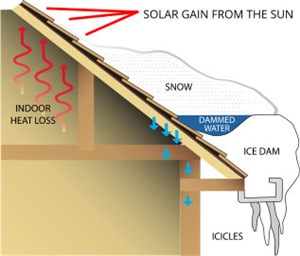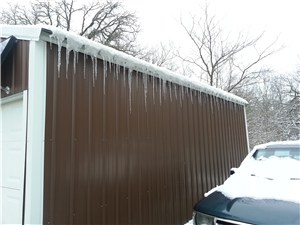Balanced Roof Ventilation
One of the many proposed solutions to roof ice dams is balanced roof ventilation. The theory is that if the temperature inside the attic space is kept below freezing, then snow will not melt on the roof and no ice dams will form. This is often accompanied by charts with arrows showing air flow and heat loss and snow on the roof causing an ice dam. This all is very accurate. Warmth from the house leaks into the attic and warms the roof surface resulting in snow melt which can refreeze at the roof edge causing an ice dam. Good practice under these conditions is to 'air seal' or stop bypasses in the attic from allowing conditioned air to escape into the attic space. This can be accomplished by the use of caulks or sealants and 'spray foam' to seal these bypasses. Also important is the use of vapor barriers (this is most often used in new construction) to prevent the movement of conditioned air into the attic space. Further good practice is installing the recommended level of insulation - typically R-40 to R-60. Let's next discuss roof ventilation.
inside the attic space is kept below freezing, then snow will not melt on the roof and no ice dams will form. This is often accompanied by charts with arrows showing air flow and heat loss and snow on the roof causing an ice dam. This all is very accurate. Warmth from the house leaks into the attic and warms the roof surface resulting in snow melt which can refreeze at the roof edge causing an ice dam. Good practice under these conditions is to 'air seal' or stop bypasses in the attic from allowing conditioned air to escape into the attic space. This can be accomplished by the use of caulks or sealants and 'spray foam' to seal these bypasses. Also important is the use of vapor barriers (this is most often used in new construction) to prevent the movement of conditioned air into the attic space. Further good practice is installing the recommended level of insulation - typically R-40 to R-60. Let's next discuss roof ventilation.
Where Roof Venting Falls Short
The codes surrounding roof ventilation were originally designed to prevent moisture build up in the attic space and to prevent shingles from over heating and failing prematurely. The idea of providing ventilation for ice dam prevention is relatively new and not easily explained. The theory is that if you keep the roof attic space below freezing, there will be no snow melt. This is easier said than done. For ventilation to work, passive air flow is needed. This results from warmer air rising and being exhausted through the upper portion of the roof and being replaced by cooler air being drawn in through the eaves. Think of how a chimney works. The warm smoke from the fire flows up the chimney. And this usually works pretty well. However, any one who has a fireplace that 'smokes' or back drafts into the house, knows that this drafting is not always easily achievable. It is also not alway easily achievable in roof drafting as well. Lower sloped roofs do not have the adequate difference in height to ensure drafting. Complex roof designs create 'eddies' that disturb the natural passive air flow. And, roof vents can become snow covered in the winter, completely defeating any possibility of venting.
What about the sun and temperature fluctuations?
Another factor that short circuits roof ventilation ice dam solutions is the sun. Yes, the sun provides enough heat energy to melt snow. This is especially the case when snow is lighter higher on roofs. We can all drive around in the winter and see a roof melting from the top down on a 20 degree day. The shingles are warmed enough to start the melting process. This water runs down under the snow pack and then refreezes in the gutter or at the roof edge. Add to that, temperatures that fluctuate above and below freezing, starting and stopping the snow melt and ice dam process. Evidence of these two factors contributing to ice dam formation can be seen in the picture to the right. This is an unheated garage (with a metal roof) that has an ice dam starting at its bottom edge. Commonly, 'the experts' claim that this doesn't happen. It doesn't take long for all of us to realize that this is not always true, especially when it is so easily observable.
to melt snow. This is especially the case when snow is lighter higher on roofs. We can all drive around in the winter and see a roof melting from the top down on a 20 degree day. The shingles are warmed enough to start the melting process. This water runs down under the snow pack and then refreezes in the gutter or at the roof edge. Add to that, temperatures that fluctuate above and below freezing, starting and stopping the snow melt and ice dam process. Evidence of these two factors contributing to ice dam formation can be seen in the picture to the right. This is an unheated garage (with a metal roof) that has an ice dam starting at its bottom edge. Commonly, 'the experts' claim that this doesn't happen. It doesn't take long for all of us to realize that this is not always true, especially when it is so easily observable.
What is the solution?
When our best efforts at air sealing and insulating do not produce the results we need or are looking for, then a Roof and Gutter Ice Dam Prevention System is called for. Let the experts at WI Ice Dam Solutions provide the direction necessary to design an effective and efficient ice dam prevention system for you. Contact Us for more information or to schedule an appointment.